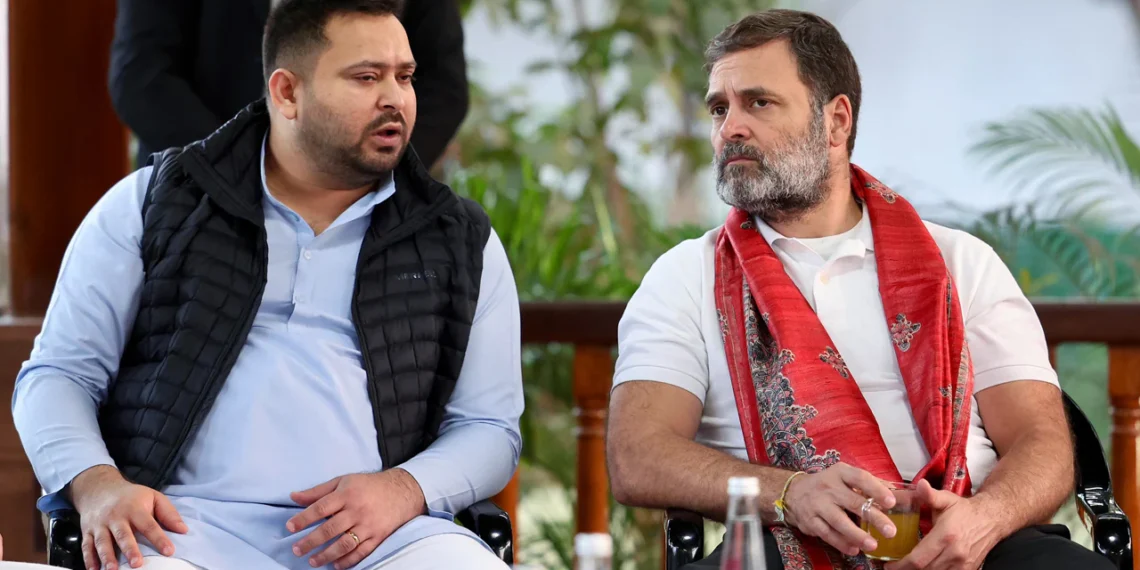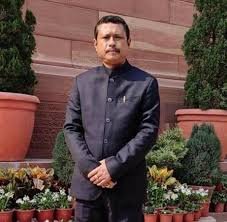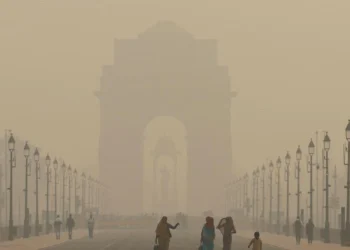Overlapping candidacies and seat clashes expose cracks in opposition unity, giving NDA a clear advantage in the upcoming polls.
By Navin Upadhyay
October 20, 2025 — As the nomination deadline for Bihar’s 2025 Assembly elections closes, the much-hyped INDIA alliance — once projected as a united front against the BJP-led NDA — now finds itself mired in chaos, contradictions, and collapsing chemistry.
What began as a coalition of conviction has fractured into a patchwork of competing candidacies, turf wars, and ego clashes. Nearly a dozen seats are witnessing overlapping claims or “friendly fights” between alliance partners — a euphemism for mutual sabotage that could hand the ruling NDA an effortless advantage in a state known for wafer-thin margins.
At the heart of this meltdown lies the visible strain between its two central figures: RJD leader Tejashwi Yadav and Congress’s Rahul Gandhi.
RJD has officially released list of 143 candidates this time, while last time they contested 144 seats. On the other hand, Congress has announced only 60 candidates, well below 70 seats contested last time. Mahaghatbandhan ? https://t.co/vXoPkNvZfY pic.twitter.com/iHQ8kvbfAw
— Rahul Gautam (@Scribe_Rahul) October 20, 2025
Seat-Sharing Turns Sour
The rift turned public over the weekend, as reports confirmed at least nine constituencies — including Lalganj (Vaishali), Bachhwara (Begusarai), and Biharsharif — where INDIA partners are directly clashing.
In Lalganj, RJD’s Shivani Shukla, daughter of the late strongman Munna Shukla, faces Congress’s Aditya Kumar Raja. Similar contests brew in Rosera, Gaura Bauram, Rajapakar, and Sikandara, each exposing the alliance’s failure to coordinate.
With nominations now sealed, analysts warn these intra-alliance fights could split opposition votes in up to 10 seats — a fatal misstep in Bihar’s hyper-competitive landscape.
The breakdown reflects a deeper trust deficit between Tejashwi and Rahul. RJD insiders say Tejashwi’s recent trip to Delhi ended without even a courtesy meeting with Rahul Gandhi. Instead, he was delegated to Congress general secretary K.C. Venugopal, leaving him “disillusioned and angry.”
“Tejashwi returned empty-handed,” said a senior RJD functionary. “He felt Congress was stalling on key seats like Kahalgaon, Narkatiaganj, and Vaishaliganj.”
Rahul’s directive to his Bihar unit — “drive a hard bargain, don’t cede an inch” — reportedly hardened Congress’s stance. The party insisted on contesting 48 seats, while RJD refused to concede beyond 55–57, leading to an impasse.
READ: Press Under Siege: Manipur’s Newsrooms Caught Between Guns and Ethics
READ: Daylight Heist at Louvre: Eight Imperial Jewels Stolen
Within the INDIA bloc, patience is wearing thin. Left leaders accuse both Congress and RJD of “big brother behavior” and lament Rahul’s lack of presence. “He’s never around when the heavy lifting starts,” said a CPI leader from Begusarai, pointing to Gandhi’s September trip to South America during critical Bihar talks.
Tejashwi’s Solo Gamble
On Diwali , Tejashwi unilaterally released a list of 143 RJD candidates, projecting himself as the de facto CM face — a move that blindsided allies and further strained ties.
Veteran observers contrast this with his father, Lalu Prasad Yadav’s coalition-building finesse during the UPA era. “Lalu knew when to fight and when to fold,” said a political commentator. “Tejashwi seems to be fighting everyone at once — allies, rivals, even time.”
Rahul’s Missing Leadership
Rahul Gandhi’s recent record with regional allies adds to the friction. His absenteeism during Haryana’s 2024 polls — where factionalism between Bhupinder Singh Hooda and Kumari Selja crippled Congress — is still cited as a cautionary tale.
The pattern, insiders say, is repeating in Bihar: a leader more comfortable with global lectures than local alliances.
Meanwhile, the NDA has moved with clockwork precision. Its seat-sharing pact — 101 each for BJP and JD(U), 29 for LJP (Ram Vilas), and smaller allocations for allies — showcases unity and clarity of purpose.
Adding to INDIA’s troubles, Prashant Kishor’s Jan Suraaj is emerging as a disruptive third force, nibbling at the
With polling scheduled for November 6 and 11, INDIA’s leadership — both congress and RJD leadership are working hard to salvage the alliance. But the damage, most insiders admit, is already done.
“We’ve managed to defeat ourselves before the first vote,” said a Congress organizer in Patna. “Without trust, there’s no alliance — only arithmetic without chemistry.”
As the campaign trail heats up, the INDIA bloc faces an uncomfortable question:
Can a coalition built on quicksand withstand Nitish Kumar’s machine and Modi’s momentum?
The math looks bleak; the morale even bleaker. What was meant to be a national comeback rehearsal may instead script the alliance’s slow unraveling — one constituency at a time.













